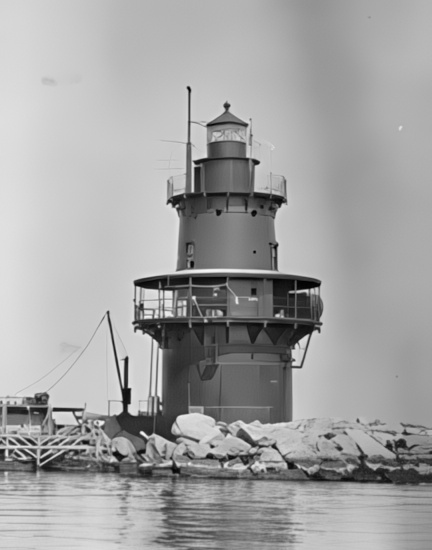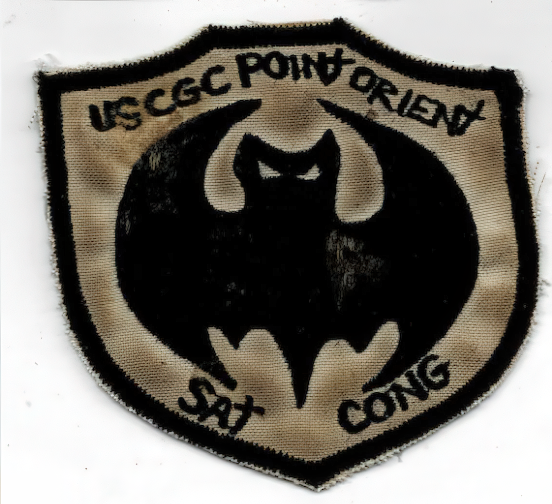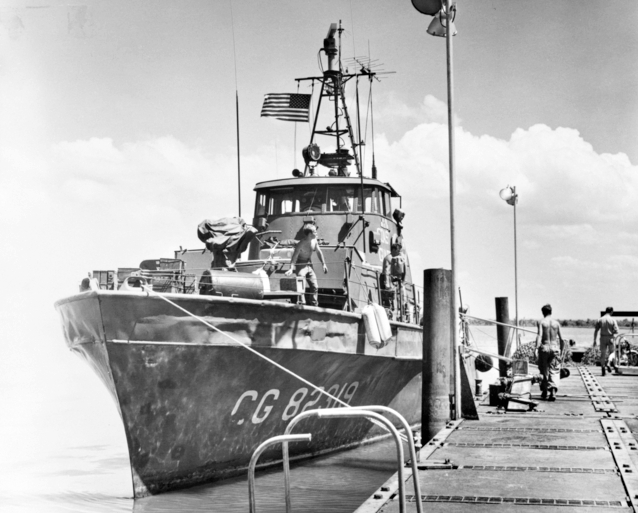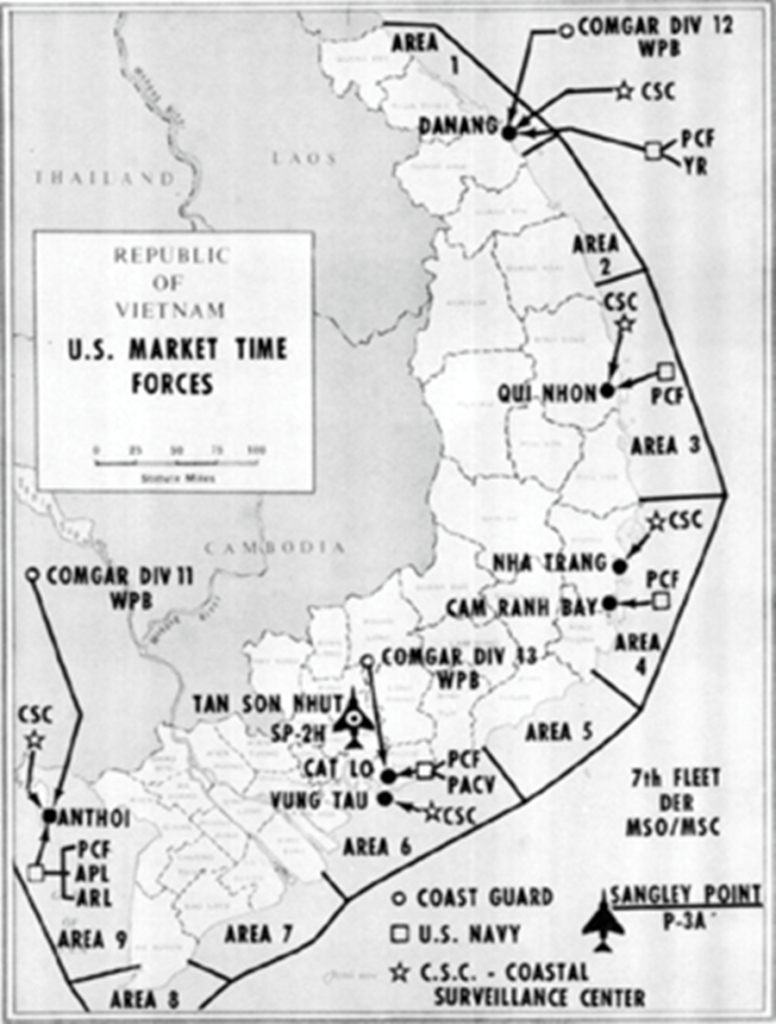The Coast Guard vessel, Point Orient, was stationed at Fort Pierce, FL, from 1961 to 1965 and was first used for law enforcement and SAR (Search and Rescue). On 15 January 1965, she towed the disabled M/V Sally 120 miles southeast of Corpus Christi, TX, to safety. She was assigned to CG Squadron One, Division 12, Vietnam, from July 1965 to May 1970. On 15 July 1967, Point Orient captured an enemy trawler. The Point-class cutters were 82-foot patrol boats designed to replace the United States Coast Guard’s aging 83-foot wooden hull patrols being used at the time.

The Early History of USCGC Point Orient
The design utilized a mild steel hull and an aluminum superstructure. Following the Coast Guard custom in place in 1960 of not naming vessels under 100 feet in length, the first 44 Point-class patrol boats were only identified by their hull number using the scheme of WPB-823xx, where 82 was the design length of the hull. Beginning in January 1964, the Coast Guard started naming all vessels 65 feet long and over. The 82-foot patrol boats were all given geographical “Point” names, e.g., Point Glover, Caution, Hope, Slocum, Jefferson, etc. This cutter was named after the USCG Orient Point Lighthouse (active 1899-present) in Suffolk County, New York.

To reduce manning requirements, the Point-class patrol boat was designed to accommodate an eight-man crew, a reduction from the 15-man crews of Cape-class cutter. Production started in early 1960 at the Coast Guard Yard at Curtis Bay, Maryland, and continued through late December 1963, producing 44 boats. Controls and alarms located on the bridge allowed one-man operation of the cutter, thus eliminating a live engineer watch in the engine room. Because of design, four men could operate the cutter; however, the need for resting watchstanders brought the crew size to eight men for normal domestic service. The screws were designed for ease of replacement and could be changed without removing the cutter from the water. A clutch-in idle speed of three knots helped to conserve fuel on lengthy patrols, and an eighteen-knot maximum speed could get the cutter on scene quickly. Air-conditioned interior spaces were a part of the original design for the Point class cutter. Interior access to the deckhouse was through a watertight door on the starboard side aft of the deckhouse. The deckhouse contained the cabin for the officer-in-charge and the executive petty officer. The deckhouse also included a small arms locker, scuttlebutt (i.e., potable water source), a small desk, and a head. Access to the lower deck and engine room was down a ladder. At the bottom of the ladder was the galley, mess, and recreation deck. A watertight door at the front of the mess bulkhead led to the main crew quarters, which were ten feet long and included six bunks that could be stowed, with three bunks on each side. Forward of the bunks was the crew’s head complete with a compact sink, shower, and commode. Accommodations for a 13-man crew were installed for Vietnam service.
Point Orient’s Role in Vietnam and Operation Market Time
At the request of the U.S. Navy, twenty-six of the Point-class cutters were transported to Vietnam to serve with Coast Guard crews under U.S. Navy control during Operation Market Time. Coast Guard Squadron One was commissioned at Alameda, California, on 27 May 1965. Crews immediately began training and preparation for overseas deployment. All USCG Point-class cutters in Vietnam were later turned over to the South Vietnamese Navy as part of the Vietnamization of the war effort. Point Orient was transferred to RVN as RVNS Nguyễn Kim Hưng (HQ-722) on 14 July 1970.

U.S. Naval Forces Vietnam (USNAVFORV) was patrolling near the north end of the shore at Tam Quan harbor in Binh Dinh Province. Point Orient approached five sampans in restricted waters, two of which escaped into the Song Tam Quan River. The other three turned off their engines and prepared for boarding by the approaching Coast Guardsmen. As Point Orient neared the sampans, heavy automatic weapons fire erupted from the shoreline to the north and west. A crewman on the cutter was killed instantly by the first hail of bullets. The Vung Ro Bay Incident in February 1965, proved categorically that North Vietnamese smugglers were infiltrating men and smuggling weapons and matériel for the communists in South Vietnam by sea. General William C. Westmoreland, commander of Military Assistance Command Vietnam (MACV), convened U.S. military commanders in the Pacific to determine how to handle the problem and stem the flow of people and contraband. As a result, Operation MARKET TIME was born.
In April 1965, Secretary of the Navy Paul H. Nitze formally requested Coast Guard assets join the U.S. Navy in their quest to cut off all seaborne communist smuggling and infiltration into South Vietnam. President Lyndon B. Johnson noted in an April 29 memorandum that the Coast Guard was particularly suited to the task, had the expertise and experience to participate effectively in the effort, and directed them to join the Navy in their interdiction endeavors. Coast Guard Squadron One (RONONE) was formed that same day. Of the “Point” Class 82-foot patrol boats, 26 were assigned to help U.S. and South Vietnamese navies patrol a 1,200-mile stretch of shallow waters off the coast of South Vietnam. The stretch began from the 17th parallel at the demilitarized zone (DMZ) and continued down to the Brevie Line in the Gulf of Thailand, which separates Vietnamese from Cambodian territorial waters. The United States Coast Guard’s Squadron One and Squadron Three participated in Operation Market Time. The U.S. Coast Guard operated, under U.S. Navy command, heavily armed 82-foot (25 m) patrol boats and large cutters armed with 5-inch naval guns, which were used in battle and gunfire support. Radar picket escort ships, based in Guam or Pearl Harbor, provide a long-term presence at sea offshore to guard against trawler infiltration. Originally built for World War II convoy duty and then modified for distant early warning (“DEW”) duty in the North Atlantic, their seakeeping capability made them ideal for long-term presence offshore, where they provided support for Patrol Craft Fast (PCF) boats, pilot rescue and sampan inspection. There were two or three on station at all times. Deployments were seven months in duration, with a four- or five-month turn-around in Pearl. When off station, they alternated duty as Taiwan Defense Patrol, with stops in Subic and Sasebo for refit mid-deployment. Operation Market Time was one of six Navy duties that began after the Tonkin Gulf Incident, along with Operation Sea Dragon, Operation Sealords, Yankee Station, PIRAZ, and naval gunfire support.

Combat and Legacy of USCGC Point Orient
Over a period of five years, approximately 8,000 U.S. Coast Guardsmen served in Vietnam. Not all of their activity was interdiction. During their service in Vietnam, the Coast Guard provided gunfire support missions, buoy tender duties, port security and waterways details, and explosives loading detachments. They also built and manned Long Range Aids to Navigation (LORAN) stations, and supplied the U.S. Air Force’s 37th Aerospace Rescue and Recovery Squadron at Da Nang with highly skilled Sikorsky HH-3E Jolly Green Giant combat search-and-rescue helicopter pilots.
From 1965 to 1970, RONONE cutters cruised over 4 million miles up and down the South Vietnamese coast, detected more than 800 thousand vessels, boarded more than 200 thousand, and inspected nearly 300 thousand junks, sampans, and trawlers. Incredibly, in all that time and throughout their perilous missions, the U.S. Coast Guard lost seven men killed in action and 59 wounded. In addition to providing patrols and illumination, Point Orient captured and killed numerous NVA enemy. Their service was deemed vital to the U.S. war effort in Vietnam. On 24 July 1965, the Point Orient became the first Coast Guard cutter to engage the enemy when she exchanged fire with a Viet Cong shore position.

COSDIV-12, based in Da Nang in I Corps, patrolled the South Vietnamese coastline from the DMZ down to Qui Nhon in II Corps. Their efforts had been noteworthy and successful, and by 1969, patrol missions had become relatively predictable and routine. On March 22, 1969, communists disrupted the status quo.
Point Orient—which in July of 1965 had been the first Coast Guard cutter to engage the enemy in combat since World War II – sighted five suspicious sampans together in restricted waters. The sampans were near the sea entrance to Tam Quan, about 56 miles north of Qui Nhon. The Point Orient crew instructed them to halt. Two of the five sampans raced off into the mouth of the Song Tam Quan River and made their escape. The other three turned off their motors and drifted toward the shoreline.
Point Orient’s small boat, a 13-foot Boston Whaler, headed over to inspect the sampans. As it drew near, automatic gunfire erupted from three different shoreline positions to the north and west, on either side of the river entrance. Fishermen caught in restricted zones habitually tried to evade the Coast Guard, but the three sampans, which had dutifully cut their engines, apparently had ulterior motives to lure the Whaler into an ambush.
The first burst of gunfire struck and killed Chief Engineman Morris S. “Bee” Beeson, Point Orient’s Engineering Officer. Beeson was born on March 8, 1932, in Pitkins, Louisiana. He died two weeks after his 37th birthday. He was a career Coast Guardsman, married, and had a son. He had served a previous tour in Vietnam from April 1967 to January 1968 aboard USCGC Halfmoon (WHEC-378). Beeson Hall, the U.S. Coast Guard Division 12 headquarters in Da Nang, was named in recognition of his service and sacrifice. The incident occurred at Tam Quan Point, which forms the northern border of Tam Quan Harbor, Binh Dinh Province. Beeson Hall, the USCG Division 12 headquarters in Da Nang, was the only Coast Guard facility named for any of the Squadron One Coast Guardsmen killed in action in Vietnam. Bill Wells, a Guardsman who served in Vietnam, maintains an informal Coast Guard Vietnam site where the photos of Chief Engineman Morris Beeson are found. They were taken by, and belong to, another Point Orient sailor, Bill Ross. The Coast Guard TWS remembrance of CPO Beeson, composed by BM2 Hugh McManus, describes the incident as follows:
“On the 22 Mar 1969, the small boat from the USCGC POINT ORIENT was checking fishing craft close inshore 56 miles north of Qui Nhon. While proceeding to board the three sampans caught in a restricted zone, heavy automatic weapons fire was received from three positions to the north and west. A crewman was struck and killed instantly by the first burst of fire. In the incident, three of the five sampans hailed by the small boat stopped their engines instead of evading up the river with the other two. Because restricted area violators had frequently been evading, the incident appeared to be a deliberate ambush with the sampans luring the small boat close to the shoreline.”
When North Vietnam eventually overtook the South, the then-South Vietnamese Navy cutters had varied fates. Some were captured and incorporated into the Vietnam People’s Navy. For this article, Jim Ellis, Point Orient’s last commanding officer, confirmed that in the Spring of 1970, the boat, one of six stationed at Da Nang, was turned over to the South Vietnamese Navy. Some USCGC/South Vietnamese boats were eventually scuttled. Others were sailed by fleeing South Vietnamese military and civilians successfully escaping to the Philippines; at this time, it is not known if Point Orient was among those. Cutters that did get there were used by the Philippine Navy, and were eventually decommissioned and sold for scrap or to the private market. Therefore, it is plausible that the boat may still be in service. Nine currently registered members of Coast Guard TWS served aboard Point Orient, one of whom, the late LCDR Chip Gillespie, is said to have written the boat’s instruction manual.
Read About Other Famous Military Units
If you enjoyed learning about USCGC Point Orient (WPB-82319), we invite you to read about other Famous Units on our blog. You will also find military book reviews, veterans’ service reflections and more on the TogetherWeServed.com blog. If you are a veteran, find your military buddies, view historic boot camp photos, build a printable military service plaque, and more on TogetherWeServed.com today.
I really enjoyed reading the Point Orient story. My dad, ENCS Ski Wojcieszak served on the PO.
I was on the Point Arden also in Danang from 1968 to 1969. Well written story.